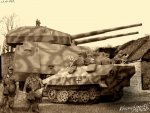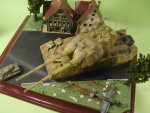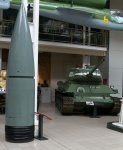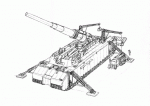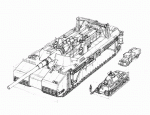- 10,884
- 821
- 113
- Location
- Appomattox, VA
Saw the thread on the "WW1 Land Battleship" (which was PB hauling a WW1 British tank, maybe 35 tons or so), and I had to post this:
"The Landkreuzer P. 1000 Ratte was to have been an extremely large tank for use by Nazi Germany during World War II. It was designed in 1942 by Krupp with the approval of Adolf Hitler, but the project was canceled by Albert Speer in early 1943 and no tank was ever completed. At 1,000 metric tons, the P-1000 would have been over five times as heavy as the Panzer VIII Maus, the largest tank ever built.
The development history of the Ratte originated with a 1941 strategic study of Soviet heavy tanks conducted by Krupp, the study also giving birth to the Panzer VIII Maus superheavy tank. The study led to a suggestion from Krupp director Grote, special officer for submarine construction, who on June 23, 1942 proposed to Hitler a 1,000-tonne tank which he named a Landkreuzer. It was to be armed with naval artillery and armored with 9 inches (23 cm) of hardened steel, so heavily that only similar weapons could hope to affect it. To compensate for its immense weight, the Ratte would have been equipped with three 1.2 metre (3.9 ft) wide treads on each side with a total tread width of 7.2 metres (24 ft). This would help stability and weight distribution, but the vehicle's sheer mass would have destroyed roads and rendered bridge crossings completely impractical. However, it was anticipated that its height, and its ground clearance of 2 metres (6.6 ft) would have allowed it to ford most rivers with ease.
Hitler became enamored with Grote's concept and ordered Krupp to begin development on it in 1942. As of December 29, 1942 a few preliminary drawings had been completed, by which time the concept had been named Ratte (Rat). Albert Speer canceled the project in 1943 before any were actually constructed.
The Ratte was to be propelled by two MAN V12Z32/44 24 cylinder marine diesel engines of 8,500 hp (6.2 MW) each (as used in U-boats) or eight Daimler-Benz MB 501 20 cylinder marine diesel engines of 2,000 hp (1.5 MW) each (as used in E-boats) to achieve the 16,000 hp (11.8 MW) needed to move this tank. The engines were to be provided with snorkels also like those pioneered by German submarines. The snorkels were of course designed to provide a way for oxygen to reach the engine, even during amphibious operations passing through deep water.
The Ratte's primary weapons would have been two 280 mm SK C/34 naval guns mounted in a modified naval heavy cruiser turret as used in the Gneisenau-class warships, fitting two guns instead of three. One such turret was supposedly built before the project was canceled, although documentation of its whereabouts is missing. It is rumored that the prototype turret was used as a coastal gun emplacement in occupied Netherlands near Rotterdam, but it now appears this turret was actually built to the specifications of the Gneisenau class and was unconnected to the Ratte Program.
Further armament was to consist of a 128 mm anti-tank gun of the type used in the Jagdtiger or Maus, two 15 mm Mauser MG 151/15 autocannons, and eight 20 mm Flak 38 anti-aircraft guns, probably with at least four of them as a quad mount. The 128 mm anti-tank gun's precise location on the Ratte is a point of contention among historians, most believing that it would have been mounted within the primary turret, with some others thinking a smaller secondary turret at the rear of the Ratte more logical. The tank was to be provided with a vehicle bay sufficient to hold two BMW R12 motorcycles for scouting, as well as several smaller storage rooms, a compact infirmary area, and a self-contained lavatory system."
TO SUM UP the Wikipedia entry above:
This tank would weigh 1,000 tons, have twin naval guns as main armament, and would have 1 128-mm secondary gun, 2 15-mm automatic cannons, and 8 20-mm anti-aircraft guns as supporting batteries. Size of the tank would be approximately 115 feet long, 46 feet wide, and 36 feet high, and consist of a crew of 20-40 personnel. Engines would combine to an output of 16,000 horsepower, with a range of 120 miles and max speed of 25mph.
If this went beyond the development phase, and based upon most WWII German tank designs, this would have been a kick-ass vehicle capable of smashing any reinforced line of armor of the time. Would definitely be a bomb magnet, though.
Pictures of the concept are attached.
"The Landkreuzer P. 1000 Ratte was to have been an extremely large tank for use by Nazi Germany during World War II. It was designed in 1942 by Krupp with the approval of Adolf Hitler, but the project was canceled by Albert Speer in early 1943 and no tank was ever completed. At 1,000 metric tons, the P-1000 would have been over five times as heavy as the Panzer VIII Maus, the largest tank ever built.
The development history of the Ratte originated with a 1941 strategic study of Soviet heavy tanks conducted by Krupp, the study also giving birth to the Panzer VIII Maus superheavy tank. The study led to a suggestion from Krupp director Grote, special officer for submarine construction, who on June 23, 1942 proposed to Hitler a 1,000-tonne tank which he named a Landkreuzer. It was to be armed with naval artillery and armored with 9 inches (23 cm) of hardened steel, so heavily that only similar weapons could hope to affect it. To compensate for its immense weight, the Ratte would have been equipped with three 1.2 metre (3.9 ft) wide treads on each side with a total tread width of 7.2 metres (24 ft). This would help stability and weight distribution, but the vehicle's sheer mass would have destroyed roads and rendered bridge crossings completely impractical. However, it was anticipated that its height, and its ground clearance of 2 metres (6.6 ft) would have allowed it to ford most rivers with ease.
Hitler became enamored with Grote's concept and ordered Krupp to begin development on it in 1942. As of December 29, 1942 a few preliminary drawings had been completed, by which time the concept had been named Ratte (Rat). Albert Speer canceled the project in 1943 before any were actually constructed.
The Ratte was to be propelled by two MAN V12Z32/44 24 cylinder marine diesel engines of 8,500 hp (6.2 MW) each (as used in U-boats) or eight Daimler-Benz MB 501 20 cylinder marine diesel engines of 2,000 hp (1.5 MW) each (as used in E-boats) to achieve the 16,000 hp (11.8 MW) needed to move this tank. The engines were to be provided with snorkels also like those pioneered by German submarines. The snorkels were of course designed to provide a way for oxygen to reach the engine, even during amphibious operations passing through deep water.
The Ratte's primary weapons would have been two 280 mm SK C/34 naval guns mounted in a modified naval heavy cruiser turret as used in the Gneisenau-class warships, fitting two guns instead of three. One such turret was supposedly built before the project was canceled, although documentation of its whereabouts is missing. It is rumored that the prototype turret was used as a coastal gun emplacement in occupied Netherlands near Rotterdam, but it now appears this turret was actually built to the specifications of the Gneisenau class and was unconnected to the Ratte Program.
Further armament was to consist of a 128 mm anti-tank gun of the type used in the Jagdtiger or Maus, two 15 mm Mauser MG 151/15 autocannons, and eight 20 mm Flak 38 anti-aircraft guns, probably with at least four of them as a quad mount. The 128 mm anti-tank gun's precise location on the Ratte is a point of contention among historians, most believing that it would have been mounted within the primary turret, with some others thinking a smaller secondary turret at the rear of the Ratte more logical. The tank was to be provided with a vehicle bay sufficient to hold two BMW R12 motorcycles for scouting, as well as several smaller storage rooms, a compact infirmary area, and a self-contained lavatory system."
TO SUM UP the Wikipedia entry above:
This tank would weigh 1,000 tons, have twin naval guns as main armament, and would have 1 128-mm secondary gun, 2 15-mm automatic cannons, and 8 20-mm anti-aircraft guns as supporting batteries. Size of the tank would be approximately 115 feet long, 46 feet wide, and 36 feet high, and consist of a crew of 20-40 personnel. Engines would combine to an output of 16,000 horsepower, with a range of 120 miles and max speed of 25mph.
If this went beyond the development phase, and based upon most WWII German tank designs, this would have been a kick-ass vehicle capable of smashing any reinforced line of armor of the time. Would definitely be a bomb magnet, though.
Pictures of the concept are attached.
Attachments
-
84 KB Views: 81
-
60.3 KB Views: 80
-
43.5 KB Views: 80
-
35 KB Views: 68



